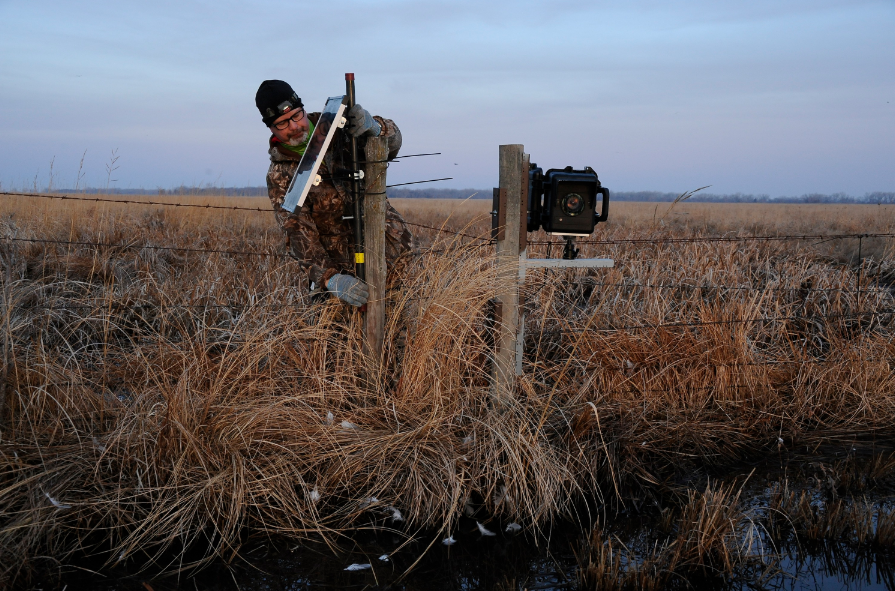
Talk of missed opportunity has led to a collaborative project that is documenting cyclical change along the Platte River Basin.
A team led by photographer Michael Forsberg and NET Television's Michael Farrell is positioning 45 digital cameras along the Platte River Basin — from its Rocky Mountain starting points in Wyoming and Colorado, to its run across Nebraska and into the Missouri River. Protected from the elements in specialized cases, the remote-control cameras capture a single photo an hour in every daylight hour of every day. The team's goal is to capture the ebb and flow of the river, showcasing how natural and manmade events change it over time.
"Whenever I go out and give talks or shoot photos, people come up and tell me how I should have been there last week, yesterday or even last year to see how the water was this high or low, or how the grass looked," Forsberg said. "That's the inspiration for this project. We want to be able to show people how the complex story of the Platte River unfolds over days, months and even years."
Now in its second year, the Platte Basin Time-lapse Project has recorded a rich beginning to that story. Cameras already placed in the field documented the high water marks of the past spring and summer seasons.
"We were very fortunate to start this project when we did," Farrell said. "We are starting out when the river is at full pool. That is going to allow us to do an entire wet to dry cycle.
"It's an amazing opportunity to bring the Platte River to life, showing how this pulse of water moves through the entire system."
This project grew from an NET documentary on Forsberg's book "Great Plains: America's Lingering Wild." While working on the documentary two years ago, Farrell and Forsberg started talking about creating an entire time-lapse of an entire ecosystem.
The duo was energized by the "cool" factor of the idea. They drafted a few others onto the team and — based on past projects on the river — selected the Platte. Farrell and Forsberg credit Jeff Dale, a friend of Forsberg's, for working through the technical issues of placing unmanned digital cameras into the weather extremes of the Midwest. With the tech needs outlined, the team crafted a budget and created a proposal to seek funding.
The proposal incorporated placing the images collected on a public website. They also planned to find UNL students in Journalism and Mass Communications, Fine and Performing Arts and Agricultural Sciences and Natural Resources to help create the website.
"NET has an internship program with those colleges and we're always looking for ways to get them involved with projects over here," said Farrell. "We want the website to be a rich experience for the user, with imagery, videos, interviews, graphs, charts and text. And, our idea is to have the students come in and help create those materials."
Development of the website continues. Images and information about the Platte Basin Time-lapse Project are available at http://www.michaelforsberg.com/pbt-i.html.
The project received financial support from Ronnie Green, NU vice president and vice chancellor for IANR; the Platte River Recovery Implementation Program; and the Cooper Foundation.
Additional support has come from James Goecke, professor in the School of Natural Resources; Dale, president of Wireless Site Services; James Balog, executive director of the Extreme Ice Survey in Boulder, Colo.; and Nikon.
Farrell said the project continues to seek additional funding to cover full development of the website and the collection of images from the cameras.
"We received funding for two fiscal years and we're part of the way into that second year," said Farrell. "The project was very labor-intensive up front. Our hope is to find decent funding that will help us make this a permanent project."
Based on presentations and discussions with faculty, campus administrators, various organization officials and the general public, Farrell and Forsberg know the project has real potential to make an impact.
"Faculty are interested in incorporating the images into research projects. The general public wants to be able to see images, to see how the river changes," Farrell said. "Time-lapse is a tool that bridges the gap between science and a general audience. It provides a window of understanding that opens to everyone."
Forsberg plans to keep collecting the images for as long as the cameras are in place and functioning.
- Troy Fedderson, University Communications
More details at: http://go.unl.edu/3ir